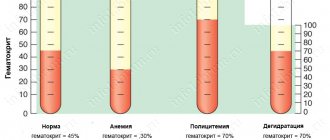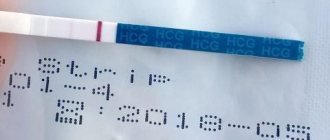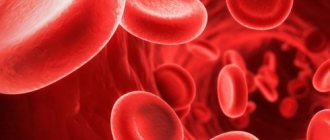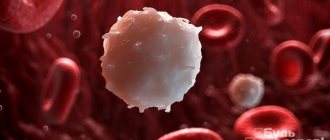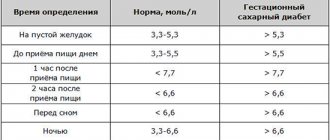Today you will learn all the most important things about blood sugar levels in children. Glucose (sugar) level is the most important indicator of human carbohydrate metabolism. Low sugar in a child or adult leads to hypoglycemia, accompanied by energy starvation of cells, decreased muscle contractility, muscle weakness, disruption of the central nervous system, etc.
Increased blood sugar in a child is observed with diabetes mellitus.
Diabetes mellitus is a severe chronic pathology in which carbohydrate metabolism is impaired, accompanied by decreased insulin secretion and an increase in blood glucose levels.
According to WHO statistics, type 1 diabetes occurs in every 500 children and every 200 adolescents worldwide.
In this regard, regular determination of blood sugar levels in children is the most important test to identify diabetes mellitus in the early stages. It should be noted that changes in blood glucose levels can be detected several years before the appearance of clear clinical symptoms of the disease.
Normal blood sugar level in a newborn baby
In the first hours after birth, a general and biochemical blood test is taken from the baby’s heel.
In a newborn baby, normal blood glucose levels can range from 2.7 mmol/l to 4.4 mmol/l. It happens that in a newborn in the first hours of life it is below the lower limit of normal. This condition is physiological, but requires mandatory correction.
Low blood glucose levels are especially dangerous for premature babies. The shorter the fetus was in the womb during pregnancy, the more difficult it is for it to adapt to the environment and adapt to independent development.
A low value of this indicator is just as bad as a high one. The baby's brain tissue does not receive enough glucose. If the actual value of blood sugar in a newborn is below normal, then this condition is compensated for by frequent breastfeeding. When the glucose level is less than 2.2 mmol/l, a diagnosis of hypoglycemia is made and this condition requires drug correction or even resuscitation measures.
By the way, we recommend reading the article Prevention of diabetes mellitus: a reminder to the patient
What are the dangers of deviations from normal values?
Comas pose a major health risk
The most dangerous complications of high and low blood glucose levels are hypo- and hyperglycemic coma.
Hyperglycemic coma is also called diabetic coma because it most often develops in patients with diabetes mellitus. It comes on gradually, with a general deterioration in health, weakness, and headache. Symptoms similar to poisoning may appear (nausea, bloating, sometimes even vomiting); after about a day, the sick person falls into a precomatose state: consciousness is depressed, speech becomes slow. Without help, the patient then falls into an unconscious state called a coma.
Hypoglycemic coma is characterized by rapid development: the patient becomes covered in cold sweat, experiences attacks of rapid heartbeat, dizziness and fear. Then comes loss of consciousness, often accompanied by convulsions.
The described manifestations are typical for significantly deviating indicators, however, even with a slight increase in blood glucose levels that lasts for several months, vascular damage begins to develop, primarily affecting the kidneys and the lens of the eye. Without proper treatment, blood glucose levels can reach life-threatening levels very quickly.
Normal blood sugar levels in children under one year of age
A child under one year of age has low blood sugar levels. This glucose content is explained by the peculiarities of the baby’s metabolism. A child at this age, especially in the first six months of life, does not perform much activity, therefore, little glucose is required as an energy source.
Also, the baby eats mostly breast milk, which is quite balanced and does not lead to high and peak sugar levels. The normal blood glucose level for an infant under one year of age is up to 4.4 mmol/l.
Who is at risk for developing hyperglycemia?
Increased blood sugar levels most often occur:
- in children with a hereditary predisposition to diabetes and disruptions in metabolic processes;
- in those children whose parents (one or both) suffer from diabetes - in the first case the risk is 10%, in the second - more than 50;
- often in twins with the corresponding heredity.
What to pay special attention to
For type 2 diabetes, it is dangerous or unfavorable:
- excess weight, often obesity becomes a provocateur of problems with carbohydrate metabolism;
- weakened immune system, lack of vitamin D in the body;
- viral damage to the pancreas - with influenza, cytomegaly, etc.
- excess weight of the baby at birth;
- early feeding of a child with unadapted food;
- excess of sweet carbohydrate foods in the diet.
Normal blood glucose levels in young children and adolescents
As children grow older, their blood glucose levels tend to match those of adults. At one year of age, the norm is a fasting sugar value of up to 5.1 mmol/l, and this value is relevant up to six years.
During this period of children's lives there is a surge in growth and development. The child’s body has adapted to the world around him, nutrition has changed, organs and organ systems work almost the same as in an adult. Blood glucose, if there are no abnormalities, tends to be within the normal range for adults.
If a child between 1 and 6 years of age has a blood test that shows 5.5–5.6 mmol/l, then the blood should be retested in compliance with all the rules. If the result repeats, you need to contact a specialist to clarify the reasons for this result.
From age six through adolescence and beyond, blood sugar levels are exactly the same as those of an adult; the norm is: less than 5.6 mmol/L in capillary blood and less than 6.1 mmol/L in venous blood (from a vein) .
Preparing for the study
The day before the test, the child should eat as usual. Fasting and overeating should not be allowed, so as not to distort the result. After dinner you should not eat any more. It will take hungry blood to understand how the body coped with the utilization of incoming sugar. For the same reason, you should not brush your teeth on laboratory day - sweet additives from the toothpaste are absorbed into the blood from the oral cavity.
If you are thirsty, you are allowed to drink plain water. It is advisable to explain to the child in advance what procedure awaits him - an injection in the finger or a vein. Someone close to you can encourage your baby during the blood draw.
If we are talking about a baby under 1 year old, the preparation rules are as follows:
- at least a 3-hour interval between the last feeding and analysis, whether breastfeeding or bottle feeding;
- give water upon request;
- Limit your child's activity to keep him calm.
Usually infants are taken for analysis first, since they are not able to fast for a long time.
Rules for donating blood for sugar
The blood of a newborn and an infant up to one year old is not often donated, only when a quantitative determination of blood glucose is required.
A child at this age eats every 3–4 hours, which makes it impossible to perform this analysis according to the rules on an empty stomach. From one year on, it is advisable to check your blood glucose levels annually if there are no indications. To obtain reliable figures, the following conditions must be met:
- blood must be donated strictly on an empty stomach (the last meal should be at least 8-10 hours before the test);
- do not brush your child’s teeth (often, children’s toothpastes have a sweetish taste and contain glucose);
- before taking the test, exclude excessive physical activity (since the indicators may be falsely elevated);
- It is undesirable to use medications (some medications can change blood glucose levels).
Stages and rules of blood sampling
Sugar analysis is carried out by professional laboratory assistants in a medical institution. Parents can come with small children, accompanied by teenagers - if they wish. Time in the office is about 5-10 minutes. depending on the method. Obtaining a blood sample from a finger prick. A newborn or an infant up to one year old is given a light puncture in the heel or toe area.
Older children have their finger pricked.
If using a one-time scarifier:
- A laboratory technician wearing sterile disposable gloves treats the skin with an antiseptic and quickly punctures the upper part of the first phalanx.
- By pressing on your finger, a transparent thin tube with a bulb at the end sucks out the required amount of blood and drains it into a test tube.
- Cover the wound with a cotton ball with antiseptic.
- The child himself or with the help of an accompanying person clamps the wound with cotton wool for 5 minutes until the blood stops oozing.
New one-time devices have appeared - lancets, which perform manipulation faster, without pain. They are a small bright capsule with an elongated spout, where a sterile pen made of medical steel is hidden. After puncturing the disinfected skin, the sharp part of the lancet is hidden and blocked. Therefore, the device cannot be reused.
Lancets are automatic and with a button. In automatic models, feathers can be changed, but there is also an additional protective mechanism that ensures complete sterility. Kids, not seeing the needle, behave calmly. The instant injection is not felt, and the required amount of blood is immediately drawn into the capsule.
Advice for parents: taking blood from a finger or vein is scary for both children and adults. You cannot show your child your anxiety, much less create panic. The younger generation intuitively senses the anxiety of their relatives. The calmer they are, the more confident the child feels. Fleeting pain will be forgotten very quickly if you show affection, pamper with a new toy, interesting entertainment.
Obtaining a blood sample from a vein
For a clarifying analysis of glucose levels or glycosylated hemoglobin in an infant, the most pronounced veins are used:
- forearms;
- back of the hand;
- calves;
- head, frontal zones.
For other children, the injection is given into the median vein of the bend of either arm. Health care workers can carry out the procedure without the presence of parents. Professional skills have been developed that make it possible to take a biosample from the most restless and capricious babies (for example, special swaddling, toys, pictures, cartoons).
Taking blood with a traditional disposable syringe looks like this:
- The health worker washes his hands with an antiseptic, wipes them with a paper towel, and puts on disposable gloves.
- The patient's arm is placed with the elbow on a rubber pad.
- Use a tourniquet to pull the middle of the forearm over clothing or a special napkin.
- Disinfects the vein and around it with a skin antiseptic.
- After clenching and unclenching your fist, a needle is inserted into the swollen vein at an acute angle.
- When blood appears in the syringe, remove the tourniquet.
- The sample taken is poured into a test tube.
- Cover the wound with a cotton ball with antiseptic. The patient should bend the elbow and sit for 5-7 minutes. until the needle insertion site is sealed with clotted blood.
New vacuum systems eliminate any contact of the collected blood, both with the hands of a healthcare worker and with the air.
The single use system consists of:
- an adapter in the form of a miniature plastic glass with a small hole at the bottom;
- a tubular block with needles at the ends;
- vacuum sealed tube.
The needle block is screwed into the hole at the bottom of the adapter. In this case, needle I in the protective cap remains outside, needle II is inside. I needle is inserted into the vein in the traditional manner. Following this, a vacuum tube is inserted into the adapter, the second needle pierces its plug, and the blood is drawn through the channel of both needles into the airless space of the container.
If it is necessary to take 2-3 samples, the filled test tube is removed from the adapter, and an empty one is quickly inserted in its place.
Tests are not indicated for a child who has a cold or is acutely ill for any other reason. We need to wait for recovery. The obtained research results are rechecked after a certain time.
Causes of elevated blood glucose levels in a child
A blood sugar level that is higher than normal indicates hyperglycemia. If the glucose test result is too high, you need to identify the origin of this.
By the way, we recommend reading the article Gestational diabetes mellitus during pregnancy: what you need to know
There are a number of reasons why it can increase:
- non-compliance with the rules for taking the analysis;
- diabetes;
- diseases of the endocrine glands (thyroid gland, adrenal glands and pituitary gland);
- overweight child.
The most important thing is to understand the root cause. If we take into account diseases, diabetes mellitus most often leads to such an increased level.
Diabetes mellitus is a metabolic disease characterized by elevated blood glucose levels. Type 1 diabetes occurs in childhood, but manifests itself by the age of 25–30.
Reasons for low sugar
Low sugar is not necessarily associated with the development of diabetes. A glucose level that is lower than normal may indicate the following disorders:
- inflammatory diseases of the digestive tract;
- poor nutrition, fasting;
- insufficient fluid intake;
- brain injury;
- poisoning with arsenic, chloroform;
- sarcoidosis;
- development of insulinoma - a hormonally active tumor of the adrenal glands that produces insulin.
Causes of low blood glucose levels in a child
Hypoglycemia is low blood sugar. Hypoglycemia is a fairly serious symptom, the cause of which must be determined as soon as possible.
Hypoglycemia is rarely detected in the following cases:
- not eating or drinking enough;
- diseases of the gastrointestinal tract (pancreatitis, gastritis);
- metabolic disease;
- formation in the pancreas - insulinoma;
- sluggish chronic diseases.
Manifestations of hypoglycemia may include anxiety and drowsiness. Severe hypoglycemia is manifested by convulsions and loss of consciousness, which is extremely rare.
Symptoms of hypoglycemia
A reduced blood glucose level indicates different causes of its origin, not similar to each other. In this case, to clarify the etiology of this condition, a full examination and consultation with specialized doctors is necessary.
Other indicators of carbohydrate metabolism
For a more accurate diagnosis of carbohydrate metabolism disorders, the following indicators can be determined:
- C-peptide;
- fructosamine;
- insulin;
- glucose in urine;
- glycosylated hemoglobin.
Your attending physician (pediatrician, endocrinologist, gastroenterologist, general practitioner) can prescribe a referral for these tests.
Indications for unscheduled blood donation for glucose testing
If the child is not worried about anything, the parents do not see any unpleasant symptoms in their baby, then a blood test for glucose levels should be taken annually. If diabetes is hereditary, parents or blood relatives have a history of this diagnosis, regular testing and early detection of abnormalities will protect the baby from the unpleasant consequences of this disease.
You should consult a doctor if your child experiences the following symptoms:
- severe thirst, dry mouth;
- frequent urination with normal drinking regimen;
- unmotivated weight loss;
- weakness, apathy;
- insomnia;
- skin itching.
Symptoms of diabetes
If you have these complaints, you need to consult a specialist in time to exclude the diagnosis of diabetes.
Doctor Komarovsky: tips
Since the causes of type 1 diabetes are not reliably known, it is almost impossible to prevent its occurrence in a child. However, according to Dr. Komarovsky, the presence of diabetes in parents, although it increases the chances of the disease developing in a child, is only to a small extent. If the mother has diabetes, the risk increases by 2%, in the father – by 5%, in both parents – within 15%.
It is generally accepted that certain infections can be a trigger in the development of type 1 diabetes, so Komarovsky advises hardening the child and getting the necessary vaccinations in a timely manner to minimize the risks of infectious diseases.
What affects the results of the analysis?
Before taking the test, the child must be absolutely ready for this, because many factors are irritants for his body. During the previous 3 days before diagnosis, you must follow a normal diet, without limiting carbohydrates. And you must stop taking medications that can affect the results.
You should not eat food 12 hours before diagnosis. When the child’s blood is already taken for analysis, he should not drink water or eat food. All that is required of him is to sit or lie quietly. If you feel weak or faint, excessive sweating, or have a cold, stop the study.
All of the above factors directly affect the results that will be obtained after deciphering the material. Only if they are strictly followed can one be confident in the accuracy of the results. Otherwise, you will need to donate blood again.
Preparatory activities
To get the maximum result from the analysis, you must adhere to the following series of recommendations before submitting it:
- 8 hours before diagnosis, do not eat food and only drink water.
- Oral hygiene should not be performed on the morning of the diagnosis.
- If you are taking certain medications, you will need to stop taking them the night before the test. If this is impossible, the child’s parents should notify the doctor. The test is carried out in the morning on an empty stomach, and blood is taken from a finger.


